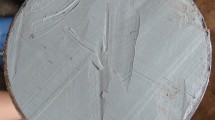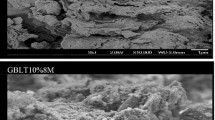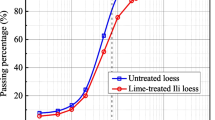Abstract
This study investigates the microstructure of lime-treated clayey soils using mercury intrusion porosimetry (MIP) and environmental scanning electron microscopy (ESEM) analyses. Parameters that were varied include lime percent (3, 6, 9%), curing duration (7, 28 days and 1 year), soil pulverization level and mellowing period (1 and 24 h). All samples were compacted at optimum water contents using standard Proctor compaction energy. The 34 MIP and several ESEM analyses conducted on these samples showed that lime content and curing duration had significant impact on the resulting microstructure. MIP results, presented as mercury intrusion curves, total porosity values and pore size distribution histograms revealed that lime stabilization changed the microfabric of clayey soils through a dynamic pore refinement process. Although increases in pore sizes and porosities were observed in the short term (up to 28 days), after a curing period of 1 year, considerable decreases in pore sizes and porosities were noted. A novel “Pore Size Amplification Factor”, (PSAF) was calculated to determine the amplification and/or deamplification of different pore size ranges compared to the untreated soil. ESEM analyses confirmed that while the addition of lime to clayey soils initially increased pore size within the microstructure, over time, as the pores became partially or even completely blocked, the pore sizes reduced. Pores of different sizes and cementation within and on the particles were visible. ESEM findings also showed that pore shapes were not always circular as is assumed in MIP analyses. The results of this study add valuable insight into the time related changes in the microfabric of lime-treated soils.















Similar content being viewed by others
References
Ganapathy GP, Gobinath R, Akinwumi II, Kovendiran S, Thangarai M, Lokesh N, Anas MS, Murugan R, Yogeswaran P, Hema S (2016) Bio-Enzymatic stabilization of a soil having poor engineering properties. Int J Civil Eng. doi:10.1007/s40999-016-0056-8
Tajdini M, Nabizadeh A, Taherkhani H (2016) Effect of added waste rubber on the properties and failure mode of kaolinite clay. Int J Civil Eng. doi:10.1007/s40999-016-0057-7
Abdi MR, Mirzaeifar H (2016) Effects of discrete short polypropylene fibers on behavior of artificially cemented kaolinite. Int J Civil Eng 14(4):253–262. doi:10.1007/s40999-016-0022-5
Mallela J, Quintus HV, Smith KL (2004) Consideration of lime stabilized layers in mechanistic-empirical pavement design. The National Lime Association, Arlington
Muller CJ (2005) Pozzolanic activity of natural clay minerals with respect to environmental geotechnics. Doctor of Technical Science, Swiss Federal Institute of Technology, Zurich
Narasimha N, Rajasekaran G (1986) Reaction products formed in lime stabilized marine clays. J Geotech Eng 122(5):329–336
Locat J, Berube MA, Choquette M (1990) Laboratory investigations on the lime stabilization of sensitive clays: shear strength development. Can Geotech J 27(3):305–314. doi:10.1139/t90-041
Dash S, Hussain M (2012) Lime stabilization of soils: reappraisal. J Civil Mater Civil Eng 24(6):707–714. doi:10.1061/(ASCE)MT.1943-5533.0000431
Beetham P, Dijkstra T, Dixon N, Fleming P, Hutchison R, Bateman J (2014) Lime stabilisation for earthworks: a UK perspective. ICE Proc Ground Improvement. doi:10.1680/grim.13.00030.
Mitchell JK (1976) Fundamentals of soil mechanics. Wiley, New York, p 422 pp.
Giesche H (2006) Mercury porosimetry: a general (Practical) overview. Part Syst Char. doi:10.1002/ppsc.200601009
ASTM D4404-10 (2010) Standard test method for determination of pore volume and pore volume distribution of soil and rock by mercury intrusion porosimetry. ASTM International, West Conshohocken
Wild S, Arabi M, Rowlands GO (1987) Relation between pore size distribution, permeability, and cementitious gel formation in cured clay–lime systems. Mater Sci Technol 3(12):1005–1011
Cuisinier O, Auriol JC, Borgne TL, Deneele D (2011) Microstructure and hydraulic conductivity of a compacted lime-treated soil. Eng Geol 123(3):187–193
Stoltz G, Cuisinier O, Masrouri F (2012) Multi-scale analysis of the swelling and shrinkage of a lime-treated expansive clayey soil. Appl Clay Sci 61:44–51
Russo G, Modoni G (2013) Fabric changes induced by lime addition on a compacted alluvial soil. Geotech Lett 3(2):93–97. doi:10.1680/geolett.13.023
Lemaire K, Deneele D, Bonnet S, Legret M (2013) Effects of lime and cement treatment on the physicochemical, microstructural and mechanical characteristics of a plastic silt. Eng Geol 166:255–261
Tran DT, Cui Y, Tang AM, Audiguier M, Cojean R (2014) Effects of lime treatment on the microstructure and hydraulic conductivity of Héricourt clay. J Rock Mech Geotech Eng 6(5):399–404. doi:10.1016/j.jrmge.2014.07.001
Wang Y, Cui Y, Tang AM, Tang C, Benahmed N (2015) Effects of aggregate size on water retention capacity and microstructure of lime-treated silty soil. ICE Publ Inst Civil Eng 5(4):269–274
Wang Y, Cui Y, Tang AM, Tang C, Benahmed N (2016) Changes in thermal conductivity, suction and microstructure of a compacted lime-treated silty soil during curing. Eng Geol 202:114–121
Wang Y, Duc M, Cui Y, Tang AM, Benahmed N, Sun WJ, Ye MY (2017) Aggregate size effect on the development of cementitious compounds in a lime-treated soil during curing. Appl Clay Sci 36:58–66
Ural N (2016) Effects of additives on the microstructure of clay. Road Mater Pavement Des 17(1):104–119. doi:10.1080/14680629.2015.1064011
Al-Mukhtar M, Khattab S, Alcover JF (2012) Microstructure and geotechnical properties of lime-treated expansive clayey soil. Eng Geol 139–140:17–27
Garaisayev S (2008) Chemical stabilization of expansive soils. M. Sc. Thesis submitted to Istanbul University, Institute of Sciences, in Turkish, p 170
Bozbey I, Garaisayev S (2010) Effects of soil pulverization quality on lime stabilization of an expansive clay. Environ Earth Sci 60:6:1137–1151. doi:10.1007/s12665-009-0256-5
Muhammed (2012) Resilient modulus of lime stabilized clays. Master of Science Thesis. Istanbul University, MA Turkish
Kamal NA (2012) Utilization lime and fly ash stabilized clays as pavement material. In Turkish, submitted to Istanbul University, Master of Science Thesis. 188 p.
Bozbey I, Kamal NA, Abut Y (2016) Effects of soil pulverisation level and freeze and thaw cycles on fly-ash- and lime-stabilised high plasticity clay: implications on pavement design and performance. Road Mater Pavement Des. doi:10.1080/14680629.2016.1207553
Holtz RD, Kovacs DK (1981) Introduction to geotechnical engineering. Prentice Hall, Upper Saddle River
Webb PA (2001) An introduction to the physical characterization of materials by mercury intrusion porosimetry with emphasis on reduction and presentation of experimental data. Micromeritics Instrument Corp., in http://www.micromeritics.com/pdf/app_articles/mercury_paper.pdf. Accessed 15 Mar 2015
Acknowledgements
This reseach was funded by Istanbul University, Scientific Research Projects Fund, Projects No. YADOP 4641 and ACIP 2993-54739. I would like to thank the anonymous reviewers for the constructive and insightful comments and suggestions.
Author information
Authors and Affiliations
Corresponding author
Rights and permissions
About this article
Cite this article
Bozbey, İ. Microfabric Evaluation of Lime-Treated Clays by Mercury Intrusion Porosimetry and Environment Scanning Electron Microscopy. Int J Civ Eng 16, 443–456 (2018). https://doi.org/10.1007/s40999-017-0151-5
Received:
Revised:
Accepted:
Published:
Issue Date:
DOI: https://doi.org/10.1007/s40999-017-0151-5




